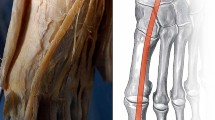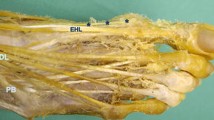Abstract
Purpose
The main tendon of the extensor hallucis longus (EHL) muscle attaches to the dorsal aspect of the distal phalanx of the great toe. One or multiple accessory tendons of the EHL have been reported in several ethnic/regional groups, except Taiwan. This study aimed to investigate the incidence, length, and insertion of the accessory tendon of the EHL in Taiwanese people.
Methods
Anatomical dissection was performed on 48 feet of 24 formalin-embalmed cadavers. The occurrence and morphological characteristics of the accessory tendon of the EHL were recorded and analyzed.
Results
The accessory tendon of the EHL was found in 97.92% (47/48) of the legs that were dissected. In one male cadaver, an independent muscle belly was identified in each leg, whereas all the other accessory tendons originated from the main tendon of the EHL. In this study, the insertion of the accessory tendon were classified into four patterns. The most common insertion sites were the first metatarsophalangeal (MTP) joint capsule and proximal phalanx of the great toe. The length of the accessory tendons did not correlate with age or with sex when the two tendons with independent muscle belly were excluded.
Conclusions
The accessory tendon of the EHL appears to be a regular feature in Taiwanese people. Most accessory tendons of the EHL (85.7%) attached on the first MTP joint capsule may play a role in the prevention of capsular impingement during great toe extension.




Similar content being viewed by others
References
Aktekin M, Uzmansel D, Kurtoglu Z, Sanli EC, Kara AB (2008) Examination of the accessory tendons of extensor hallucis longus muscle in fetuses. Clin Anat 21:713–717
Al-saggaf S (2003) Variations in the insertion of the extensor hallucis longus muscle. Folia Morphol (Warsz) 62:147–155
Arora AK, Verma P, Abrol S (2011) Study of extensor hallucis longus muscle in adult human cadavers of Punjab. J Life Sci 3:101–105
Bayer T, Kolodziejski N, Flueckiger G (2014) The extensor hallucis capsularis tendon-a prospective study of its occurrence and function. Foot Ankle Surg 20:192–194
Bibbo C, Arangio G, Patel DV (2004) The accessory extensor tendon of the first metatarsophalangeal joint. Foot Ankle Int 25:387–390
Boyd N, Brock H, Meier A, Miller R, Mlady G, Firoozbakhsh K (2006) Extensor hallucis capsularis: frequency and identification on MRI. Foot Ankle Int 27:181–184
Denk CC, Oznur A, Sürücü HS (2002) Double tendons at the distal attachment of the extensor hallucis longus muscle. Surg Radiol Anat 24:50–52
Egea JM, Cabeza L, Ortiz R, Rama AR, Melguizo C, Prados J (2019) Double origin of the extensor hallucis longus muscle: a case report. Surg Radiol Anat 41:1421–1423
Gruber W (1875) Über die varietäten des musculus extensor hallucis longus. Arch Anat Physiol Wissen Med 1875:565–589
Hallisy JE (1930) The muscular variations in the human foot: a quantitative study. Am J Anat 45:411–442
Jarusriwanna A, Thamphongsri K, Chuckpaiwong B (2016) Frequency and characteristics of extensor hallucis capsularis: a cadaveric study. J Med Assoc Thai 99:1215–1219
Kato T, Watanabe S (1981) The etiology of hallux valgus in Japan. Clin Orthop Relat Res 157:78–81
Lundeen RO, Latva D, Yant J (1983) The secondary tendinous slip of the extensor hallucis longus (extensor ossis metatarsi hallucis). J Foot Surg 22:142–144
Macalister A (1875) Additional observations on muscular anomalies in human anatomy. (Third series) With a catalogue of the principal muscular variations hitherto published. Trans Roy Irish Acad 25:1–134
Mann RA, Coughlin MJ (1981) Hallux valgus-etiology, anatomy, treatment and surgical considerations. Clin Orthop Relat Res 157:31–41
Moore KL, Dalley AF, Agur AMR (2018) Lower limb. Clinically oriented anatomy, 8th edn. Wolters Kluwer, Pennsylvania, pp 747–750
Natsis K, Konstantinidis GA, Symeonidis PD, Totlis T, Anastasopoulos N, Stavrou P (2017) The accessory tendon of extensor hallucis longus muscle and its correlation to hallux valgus deformity: a cadaveric study. Surg Radiol Anat 39:1343–1347
Nix S, Smith M, Vicenzino B (2010) Prevalence of hallux valgus in the general population: a systematic review and meta-analysis. J Foot Ankle Res 3:21
Olewnik Ł, Podgórski M, Polguj M, Ruzik K, Grzelak P (2020) Is ultrasound effective in determining variation of the insertion of the extensor hallucis longus tendon? Clin Anat. https://doi.org/10.1002/ca.23572
Olewnik Ł, Podgórski M, Polguj M, Ruzik K, Topol M (2019) A cadaveric study of the morphology of the extensor hallucis longus - a proposal for a new classification. BMC Musculoskelet Disord 20:310
Park JH, Choi YJ, Park KR, Kim D, Kwon HW, Lee M, Cho J (2020) Independent muscle of extensor hallucis capsularis: a cadaveric case report. Surg Radiol Anat. https://doi.org/10.1007/s00276-020-02592-7
Sim-Fook L, Hodgson AR (1958) A comparison of foot forms among the non-shoe and shoe-wearing Chinese population. J Bone Joint Surg Am 40–A:1058–1062
Tank PW (2005) Grant’s dissector, 13th edn. Lippincott Williams & Wilkins, Maryland
Testut L, Latarjet A (1928) Traité d’anatomie humaine, vol 1. Doin, Paris, p 1149
Tubbs RS, Shoja MM, Loukas M (2016) Bergman’s comprehensive encyclopedia of human anatomic variation. Wiley, New Jersey
Wood J (1867) Variations in human myology observed during the winter session of 1866–1867 at King’s College London. Proc R Soc Lond 15:518–546
Zdilla MJ, Paulet JE, Lear JJ, Addie KM, Lambert HW (2018) A review of extensor hallucis longus variants featuring a novel extensor primi internodii hallucis muscle merging with extensor hallucis brevis. J Foot Ankle Surg 57:1218–1220
Acknowledgements
The authors are grateful to those altruistic silent mentors who donated their bodies to the Tzu Chi Body Donation Program for medical education. We also thank Mr. Yi-Fan Chen for image processing and Enago for the English language editing.
Funding
None.
Author information
Authors and Affiliations
Contributions
K-CL: data acquisition and analysis, drafting of manuscript. H-WT: data acquisition, revision. L-JC: data acquisition, revision. P-HL: data acquisition, revision. G-FT: data acquisition, revision. H-CH: data acquisition, drafting of manuscript and critical revision.
Corresponding author
Ethics declarations
Conflict of interest
The authors declare no competing financial interests.
Ethics approval
The research was done in the Gross Anatomy Laboratory course for medical students. All cadavers were obtained through the Tzu Chi Body Donation Program with written consents, dedicated to medical education.
Informed consent
Written consents were obtained from all our donors through the Tzu Chi Body Donation Program.
Additional information
Publisher's Note
Springer Nature remains neutral with regard to jurisdictional claims in published maps and institutional affiliations.
Rights and permissions
About this article
Cite this article
Lai, KC., Tan, HW., Chen, LJ. et al. Characteristics of the accessory tendon of the extensor hallucis longus muscle: a Taiwanese study. Surg Radiol Anat 43, 1053–1059 (2021). https://doi.org/10.1007/s00276-020-02648-8
Received:
Accepted:
Published:
Issue Date:
DOI: https://doi.org/10.1007/s00276-020-02648-8




